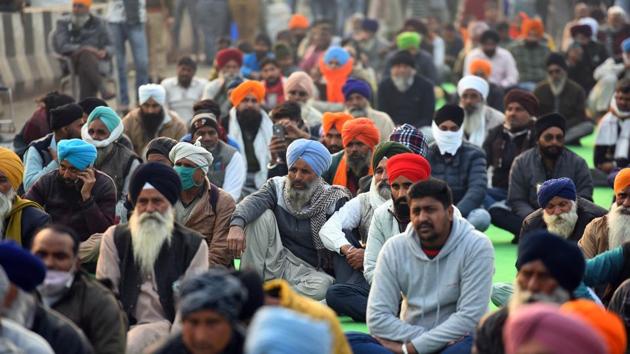Farmers and workers were seen thronging the streets of every major city in the country during the past few months. They are unified in their agenda: farmers are demanding the repeal of the three farm bills passed by the government, while workers have been protesting against longer working hours and lower wages which are gradually becoming the norm particularly since the lockdown. The latter group includes the gig workers of Swiggy, and the ASHA workers. These images of the working class unified in their claims are reminiscent of the scenes of Mrinal Sen’s film, Chorus.
Farmers are demanding the repeal of the three farm bills passed by the government, while workers have been protesting against longer working hours and lower wages which are gradually becoming the norm particularly since the lockdown. These images of the working class unified in their claims are reminiscent of the scenes of Mrinal Sen’s film, Chorus.

Chorus focused on the angst of workers and farmers spilling onto the streets. They were exasperated with the oppression and exploitation meted out to them. It was triggered by the systemic deprivation of the workers through high unemployment, lack of vacancies, and poor compensations paid to employed workers. Contrastingly, the capitalists, considering themselves ‘saviours’ of the unemployed, offered a mere hundred jobs to thirty thousand job applicants. A similar sentiment is being observed by the incumbent government which has tried to play the role of a ‘saviour’ through the adoption of greater liberalisation policies. This is being undertaken by facilitating the entry of capitalist lobby in the agricultural sector, which has given rise to fears of discontinuation of minimum support prices to farmers, intensified misery of small and marginal farmers, and fluctuating food prices, among others. It is ironic that the ‘saviours’, however, have no qualms in thwarting the resistance of the famers through lathi charges and barricades.
Also read: Mapping The Migrant’s City Through Muzaffar Ali’s Gaman (1978)
The capitalist system which Sen attacked in Chorus, perpetuates through profit maximisation. This necessitates the minimisation of cost by reducing wages paid to workers, providing negligible social security, and maintaining a steady pool of unemployed workers. These characteristics of the system and the associated repercussions were visible in Chorus. The plight of low-waged workers engaged in poor quality employment, as well as that of unemployed were clearly highlighted. Such vile effects of a capitalistic economy encapsulated by Sen in this 1974 film, has only worsened over time. Liberalisation policies adopted by the country after the 1991 crisis has integrated India with the global economy, which has been accompanied by greater privatisation. The government has been liberal with providing cheap resources, raw materials and labour in order to encourage the business environment. Accordingly, capitalists’ quest for maximising profits has been served. Several academic papers have highlighted the consistently decreasing share of wages along with a steadily rising share of profits in gross value added in the organised manufacturing sector since the 1990s. Additionally, the recent Periodic Labour Force Survey (2018-19) data show that while 25 percent of the workforce are employed as regular wage, salaried workers, the percentage of workforce having access to all forms of social security has not exceeded 3 percent in the last fourteen years.
Aided by the government, the capitalist system furthers its motive of profit maximisation. Although this is not a new phenomenon, the current government has served the capitalist interest with unparalleled enthusiasm. Since the lockdown, new labour codes have been introduced, with some state governments proposing an increase in working hours in industries and suspension of other labour laws for a period of two to three years. These are done on the pretext of luring private investment to improve the Ease of Doing Business, at the cost of greater flexibilities in hiring and firing of workers. Finally, the government passed the farm bills which are but tacit agreements with big corporates, oblivious to the adverse impact this will gradually have on farmers’ incomes and on consumers through unstable prices of major food items.

Also read: The Partition Of Bengal: Challenges Faced By Women And Migrants
This is the basic functioning of capitalism, the system against which workers and peasants agitated in Chorus, who were united against the continuous capitalist exploitation. The ending sequence of the film portrayed that the capitalists or the ‘saviours’ of the unemployed, were being swarmed by resisting workers.
This is the basic functioning of capitalism, the system against which workers and peasants agitated in Chorus, who were united against the continuous capitalist exploitation. The ending sequence of the film portrayed that the capitalists or the ‘saviours’ of the unemployed, were being swarmed by resisting workers. Similarly, farmers in India have openly declared their stance against both the government and the corporates like Adani and Ambani. Lathi charges, water cannons, rains and cold waves, being labelled as ‘Khalistanis’, and continuous fall through of meetings with the government, have failed to dampen the spirit of the farmers. The capitalists and the government are being haunted by a spectre of unified rebellion of workers, peasants and students. Scaring or bribing them away won’t deter them because, as the protestors in Chorus chanted, ‘Hum bhoonkh se marne wale, kya maut se darne wale.’
Satyaki Dasgupta is currently pursuing a PhD at Colorado State University. He is interested in labour economics, Marxian theory, cricket and Pink Floyd. He can be found on Facebook.
Annesha Mukherjee is currently an M.Phil. Research Scholar at the Centre for Development Studies in Trivandrum, Kerala. She loves reading fiction, is an avid fan of Japanese anime, and is interested in gender economics. She can be found on Facebook.




